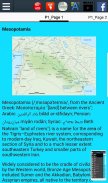








Ancient Mesopotamia History

Mô tả của Ancient Mesopotamia History
Mesopotamia (/ˌmɛsəpəˈteɪmiə/, Ancient Greek: Μεσοποταμία "[land] between rivers"; from Ancient Armenian Միջագետք (Mijagetq); Arabic: بلاد الرافدين bilād ar-rāfidayn; Kurdish: میزۆپۆتامیا; Persian: میانرودان miyān rodān; Syriac: ܒܝܬ ܢܗܪܝܢ Beth Nahrain "land of rivers") is a name for the area of the Tigris–Euphrates river system, in modern days roughly corresponding to most of Iraq plus Kuwait, the eastern parts of Syria, Southeastern Turkey, and regions along the Turkish-Syrian and Iran–Iraq borders.
Widely considered to be one of the cradles of civilization by the Western world, Bronze Age, Mesopotamia included Sumer and the Akkadian, Babylonian, and Assyrian empires, all native to the territory of modern-day Iraq. In the Iron Age, it was controlled by the Neo-Assyrian and Neo-Babylonian Empires.
The Sumerians and Akkadians (including Assyrians and Babylonians) dominated Mesopotamia from the beginning of written history (c. 3100 BC) to the fall of Babylon in 539 BC, when it was conquered by the Achaemenid Empire. It fell to Alexander the Great in 332 BC, and after his death, it became part of the Greek Seleucid Empire.
Around 150 BC, Mesopotamia was under the control of the Parthian Empire. Mesopotamia became a battleground between the Romans and Parthians, with western parts of Mesopotamia coming under ephemeral Roman control. In AD 226, eastern part of it fell to the Sassanid Persians. Division of Mesopotamia between Roman (Byzantine from AD 395) and Sassanid Empires lasted until the 7th century Muslim conquest of Persia of the Sasanian Empire and Muslim conquest of the Levant from Byzantines. A number of primarily neo-Assyrian and Christian native Mesopotamian states existed between the 1st century BC and 3rd century AD, including Adiabene, Osroene, and Hatra.
Mesopotamia is the site of the earliest developments of the Neolithic Revolution from around 10,000 BC.[citation needed] It has been identified as having "inspired some of the most important developments in human history including the invention of the wheel, the planting of the first cereal crops and the development of cursive script, mathematics, astronomy and agriculture."
Lưỡng Hà (/ ˌmɛsəpəteɪmiə /, cổ đại Hy Lạp: Μεσοποταμία "[đất] giữa sông", từ cổ Armenia Միջագետք (Mijagetq); tiếng Ả Rập: بلاد الرافدين Bilad ar-rāfidayn; Kurd: میزۆپۆتامیا; Ba Tư: میانرودان miyān Rodan; Syria: ܒܝܬ ܢܗܪܝܢ Beth Nahrain "đất của con sông") là một tên cho khu vực của hệ thống sông Tigris-Euphrates, tận ngày nay khoảng tương ứng với hầu hết Iraq cộng với Kuwait, phần phía đông Syria, đông nam Thổ Nhĩ Kỳ, và khu vực dọc theo biên giới Thổ Nhĩ Kỳ-Syria và Iran-Iraq.
Được coi là một trong những cái nôi của nền văn minh của thế giới phương Tây, đồ đồng, Mesopotamia bao gồm Sumer và Akkad, Babylon, và đế quốc Assyria, tất cả nguồn gốc từ lãnh thổ của Iraq ngày nay. Trong thời đại đồ sắt, nó được điều khiển bởi Empires Neo-Assyrian và Neo-Babylon.
Người Sume và Akkadians (bao gồm Assyria và Babylon) thống trị vùng Lưỡng Hà từ đầu lịch sử bằng văn bản (c. 3100 TCN) đến sự sụp đổ của Babylon năm 539 trước Công nguyên, khi nó bị chinh phục bởi Đế chế Achaemenid. Nó rơi xuống Alexander Đại đế trong 332 trước Công nguyên, và sau khi ông chết, nó đã trở thành một phần của Hy Lạp Vương quốc Seleukos.
Khoảng 150 trước Công nguyên, Lưỡng Hà là dưới sự kiểm soát của Đế quốc Parthia. Lưỡng Hà đã trở thành một chiến trường giữa những người La Mã và Parthia, với các bộ phận phía tây của vùng Lưỡng Hà đến kiểm soát Roman phù du. Trong AD 226, phần phía đông của nó rơi vào tay người Ba Tư Sassanid. Phòng Mesopotamia giữa La Mã (Byzantine từ AD 395) và Sassanid Empires kéo dài cho đến cuộc chinh phục của người Hồi giáo thế kỷ thứ 7 of Persia của Đế quốc Sasanian và cuộc chinh phục của người Hồi giáo Levant từ Byzantine. Một số tiểu bang Lưỡng Hà có nguồn gốc chủ yếu tân Assyria và Christian tồn tại giữa BC thế kỷ thứ 1 và thứ 3 thế kỷ, bao gồm Adiabene, Osroene, và Hatra.
Lưỡng Hà là trang web của sự phát triển sớm nhất của cuộc cách mạng đồ đá mới từ khoảng 10.000 trước Công nguyên. [Cần dẫn nguồn] Nó đã được xác định là có "lấy cảm hứng từ một số trong những phát triển quan trọng nhất trong lịch sử nhân loại bao gồm cả việc phát minh ra bánh xe, trồng đầu tiên cây ngũ cốc và sự phát triển của kịch bản chữ thảo, toán học, thiên văn học và nông nghiệp ".
























